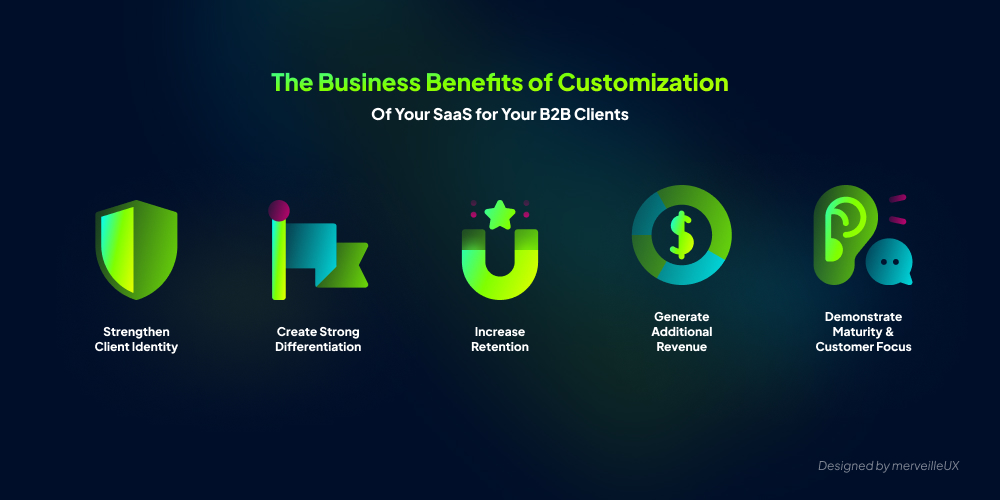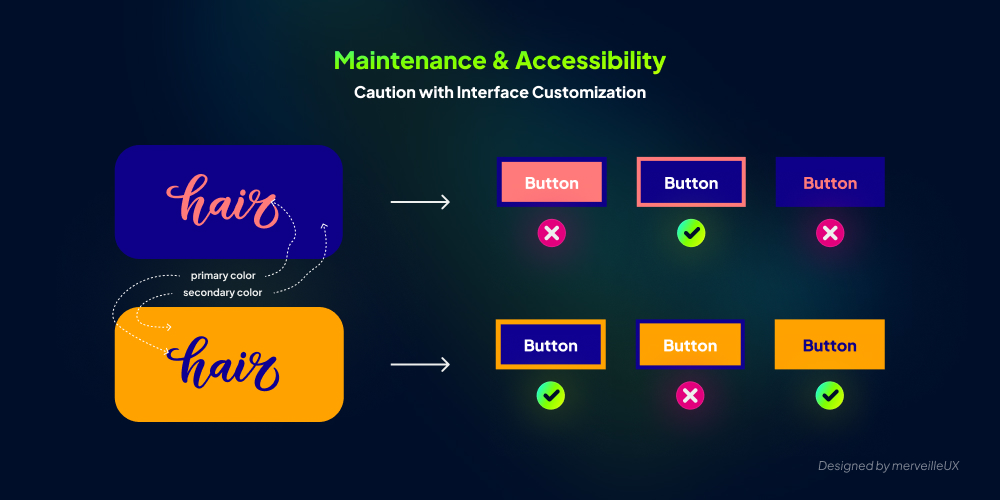Picture this: Your clients practically live in your SaaS app day in and day out. It’s their go-to tool, their digital hub for getting work done. But does its look and feel truly integrate with their brand identity, or does it always feel distinctly... well, yours? Many SaaS platforms stick to a standard, one-size-fits-all approach. Sure, it checks the functional boxes. But does it go further? Does it build deep loyalty and make users want to integrate it fully into their world? Now, what if you handed them the brush? What if they could tailor the interface to perfectly match their own brand's look and feel? We're talking way beyond just slapping on a logo. Imagine offering complete color systems, custom themes, or even a full white-label experience where your brand disappears entirely. This isn't just window dressing; it's a serious strategic advantage. Get it right, and personalization deepens that sense of ownership, drives stickiness, sets you apart from competitors, and can even unlock entirely new revenue streams. Ready to see how customizing your interface can become a powerful growth engine? Let's get into it.
Table of contents
Interface Customization: Let's Define Our Terms
Before diving into the why, let's get clear on the what. The term 'customization' gets thrown around a lot, often covering different concepts:
- Basic Customization (The Essentials): This is square one. We're talking about letting clients swap in their logo and maybe pick a primary accent color. Easy enough to implement, but the overall look and feel largely remains the provider’s (meaning, yours).
- Theming / Color Systems (The Next Level): Here, we step it up. The client can define a more comprehensive color palette (primary, secondary, error, success, background, text...) that applies consistently across the *entire* interface. The goal? A much deeper visual integration, making the tool feel like a native part of the client's ecosystem.
- White-Labeling (Full Ownership): This is the holy grail of customization. The SaaS provider's branding completely disappears, replaced by the client's. Logo, colors, sometimes even the domain name... The tool appears as if the client built it themselves. Perfect for reseller strategies or ultra-deep integration.
More Than Just a Pretty Face: The Business Benefits of Customization
Think it’s just about aesthetics? Think again. Letting your clients customize your SaaS interface goes way beyond looks. It’s a powerful engine with tangible business benefits.
Strengthen Client Identity
Allowing clients to apply their colors and logo lets them truly make the tool their own. It integrates not just with their processes, but with their brand image too. This is crucial if their own employees or their end-customers see the interface – brand consistency is reinforced, boosting their perceived professionalism. It’s a game-changer for them.
Create Strong Differentiation
In the often crowded SaaS market, every detail counts. Offering advanced customization options, or even white-labeling (where your branding disappears entirely in favor of theirs), becomes a real competitive edge. White-labeling, in particular, opens the door to lucrative reseller or partnership strategies that your more rigid competitors can’t touch.
Increase Retention (Boost Stickiness)
A client who has invested time (and potentially money) configuring the tool to their liking is less likely to leave. The application becomes a natural extension of their environment. It gets more deeply embedded in their daily workflow, making switching solutions more costly and complex – a significant advantage for reducing your churn.
Generate Additional Revenue
Let’s be clear: advanced customization and white-labeling are high-value features. They fully justify higher pricing tiers ("Enterprise," "Premium") and represent a direct opportunity to increase your recurring revenue (MRR/ARR) through upsells. That’s monetizable value right there.
Demonstrate Maturity and Customer Focus
Offering these options isn't trivial. It shows your product is mature, flexible, and that you understand the specific needs of business clients seeking consistency and control. It's a sign of reliability that bolsters your own image as an attentive and adaptable provider.

The Hidden Challenges: Complexity, Maintenance, and Accessibility
Ah, the sweet promise of an interface decked out in client colors! Except, technically, it's a bit like juggling cooked spaghetti. Dynamically managing CSS styles for every client, ensuring the slightest update doesn’t turn their dashboard into an unsolicited piece of abstract art – it can quickly spiral into a monumental technical nightmare. Consider yourself warned.
And maintenance? It’s the gift that keeps on giving... work. Every new feature, every tiny tweak now has to pass the test: "Does this still work with Customer X's 'teal-on-mustard' theme?" Multiply that by the number of clients using customization, and you’ve got long nights ahead for your dev and QA teams. Fun.
But the real trap, the one lurking in the shadows with a sly grin, is accessibility. It's cute when a client proudly picks light gray text on an off-white background to match their brand guidelines. Until half their users (and potentially regulatory bodies in certain regions) come after you because, well... they can't see a thing. The risk? An application that's unusable for some, possibly even illegal. And who’s responsible? Good question. This is where a bit of UX guidance and smart guardrails become your best friends, preventing client creativity from backfiring on everyone (including themselves).

Finally, the height of irony: don't forget the user experience... for the person doing the customizing! If the interface you provide for making these changes looks like a puzzle itself, you’ve just created another layer of frustration. Think about it.
So, mission impossible? No, but it definitely requires more thought than it might seem. Luckily, there are structured approaches to avoid the chaos...
The Cornerstone of Customizable Interfaces: The Design System
What's a Design System, in simple terms? Imagine the visual and technical source of truth for your interface. It's a centralized library of all your reusable components (buttons, form fields, cards, etc.) along with the clear rules of the game: how they should be used, official colors, typography, spacing... Basically, the playbook for building consistently.
And for customization, this is where the (controlled) magic happens, largely thanks to Design Tokens. What are those? Think of them as central switches for all your visual properties. Instead of hard-coding the color "blue #007bff" in 50 different places, you use a variable, a "token" (like $primary-color). When a client wants their interface to be green, you just change the value of that central *token* for their specific theme. And *poof!* (yes, it's technical), the entire interface adapts consistently, without having to dig through every nook and cranny of the code.
⚠️ Heads up: If it were *that* simple, it’d be too easy. The primary color will likely have several variants (lighter, darker, etc.), and text legibility on each variant also needs to be managed as tokens. Check out our article on Design Tokens to better understand their complexity.

The advantages for customizable SaaS interfaces become clear:
- Consistency Guaranteed: Customization applies uniformly wherever the token is used. No more 'Submit' button staying blue when everything else has turned green.
- Simplified Maintenance: Updates are less of an obstacle course. Modifying a style or adding a component becomes more predictable because everything relies on this shared structure. Your developers will thank you (maybe).
- Built-in Accessibility: And here’s the stroke of genius! In a well-designed DS, you can build in guardrails. Automatically prohibit color combinations with insufficient contrast? Check if the minimum font size is respected? It's possible! The DS becomes the guardian of best practices, limiting the risk of clients unknowingly creating an unusable interface. This is where sharp UX expertise upfront makes all the difference in building these smart rules.
In short, the Design System transforms the challenge of customization from a potential minefield into a structured and controlled process. It's the upfront investment that saves you many headaches down the line. Learn more about Design Systems for SaaS in our dedicated article.
Conclusion
Offering an interface in your clients' colors is not a cosmetic luxury, but a genuine strategic investment for an ambitious B2B SaaS. It's a powerful lever for adoption, retention, and your market positioning.
But (because there's often a but), to prevent the promise from turning into a technical headache or unintentional user exclusion, the approach must be structured. A well-thought-out Design System is your best ally here, along with constant vigilance on accessibility issues. That's the prerequisite for offering this flexibility smoothly and responsibly.
So, the real question is: Is your SaaS ready to take this step and reap the rewards?
If you're asking yourself that question, or if you're looking for how to tackle this project smartly, the merveilleUX team is here to help. Don't hesitate to contact us or book a call to discuss!
Discover how our mockup and prototype services can bring your ideas to life! Explore our full range of design solutions and let our experts create custom mockups for your business. Ready to turn your concepts into reality?



